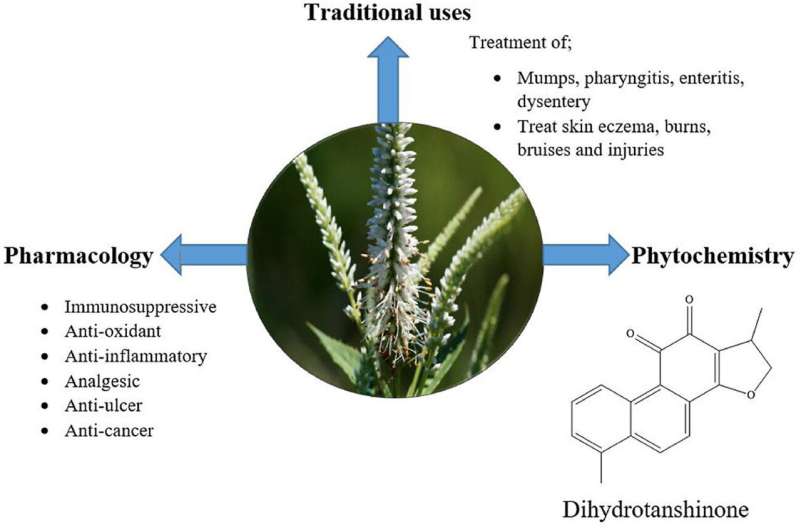Graphical abstract. Credit: Journal of Ethnopharmacology (2022). DOI: 10.1016/j.jep.2022.115695
The genus Veronicastrum (Plantaginaceae) has about 20 species in the world with a distribution in eastern Asia and North America. Species in the genus Veronicastrum are beautiful perennial herbs with mostly alternate leaves, five sepals, and a tubular corolla with four lobes. It is tubular straight or slightly curved, usually with a ring of villous hairs inside.
This genus has various uses in China in the treatment of diseases such as schistosomiasis, rheumatism, gastric ulcer, fever, chronic nephritis, liver damage, and other diseases. Despite the widespread use of this genus in traditional medicine, few review articles on its traditional uses, phytochemistry and pharmacology have been seen.
Through an extensive search and review of online databases, reports and books, researchers from the Wuhan Botanical Garden of the Chinese Academy of Sciences (CAS) have collected and compiled information on the ethnobotany, phytochemistry and pharmacology of Veronicastrum species, which is important for systematically evaluating its medicinal potential for the development of related drugs and promoting the rational development and application of plant resources of this genus.
According to the researchers, a total of 11 Veronicastrum species were used as ethnomedicines with the highest use recorded in China. The chemical constituents isolated from species of this genus have been reported to comprise iridoids, terpenoids, flavonoids, carbohydrates, phytosterols, and phenolic compounds among others.
Additionally, these compounds had various pharmacological activities, such as antioxidant, anticancer, immunosuppressive, anti- inflammatory, analgesic, and gastroprotective activities, which provided theoretical support for their wide range of ethnobotanical uses. The genus Veronicastrum has promising prospects as a potential candidate for drug discovery for treating several diseases.
However, toxicological and safety studies on this genus are currently very limited, which greatly limits its clinical application. Therefore, further studies on the toxicology, drug criteria and mechanism of action of its extracts and compounds are particularly important to ensure quality, safety and efficacy.
The review paper entitled "A Review on the Traditional Uses, Phytochemistry, and Pharmacology of the genus Veronicastrum (Plantaginaceae)" was published in the Journal of Ethnopharmacology.
More information: Elizabeth Syowai Mutinda et al, A review on the traditional uses, phytochemistry, and pharmacology of the genus Veronicastrum (Plantaginaceae), Journal of Ethnopharmacology (2022). DOI: 10.1016/j.jep.2022.115695
Journal information: Journal of Ethnopharmacology
Provided by Chinese Academy of Sciences
























